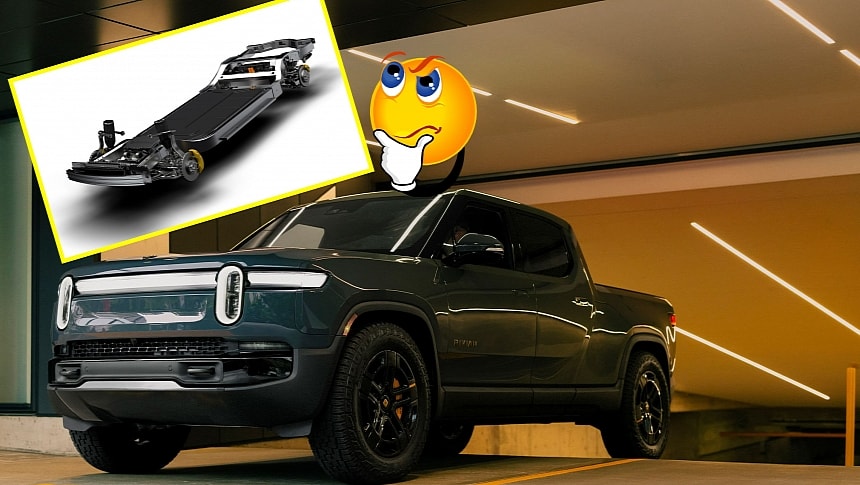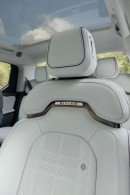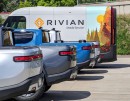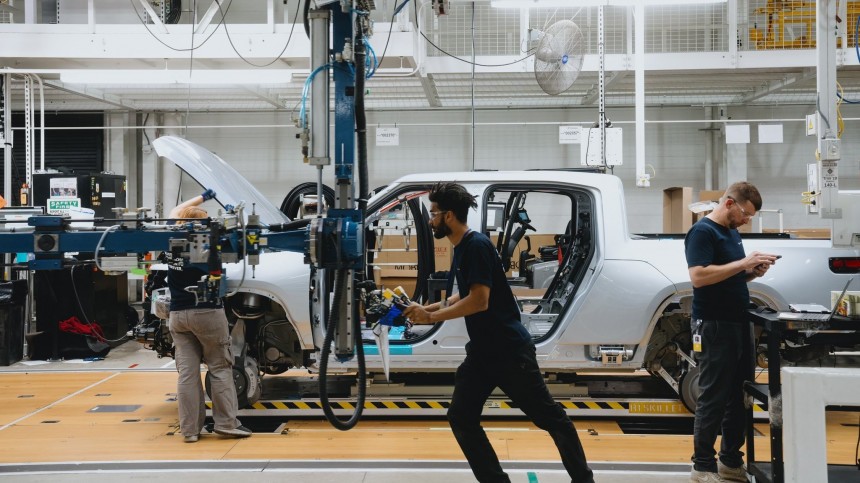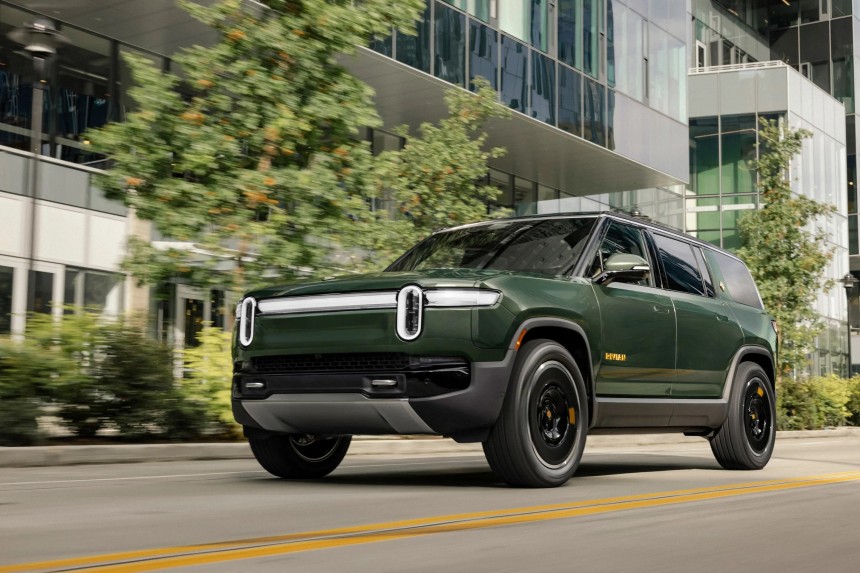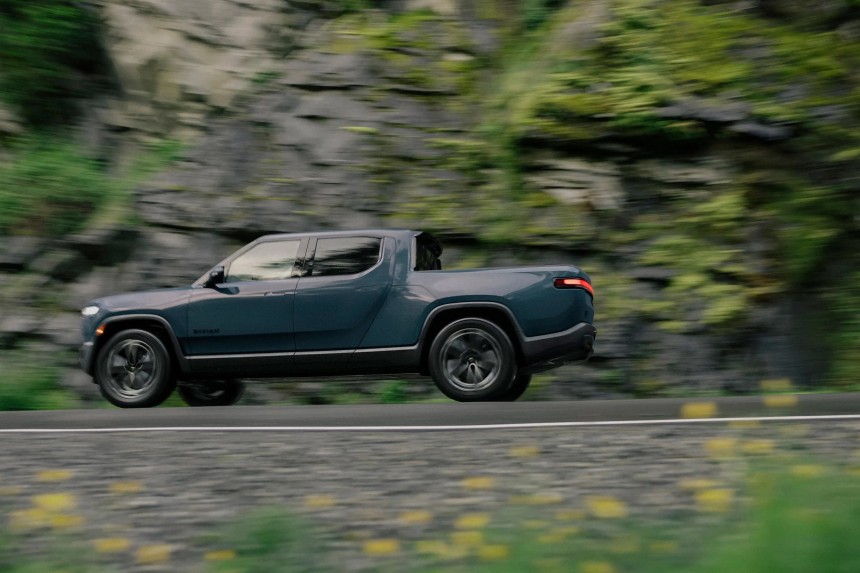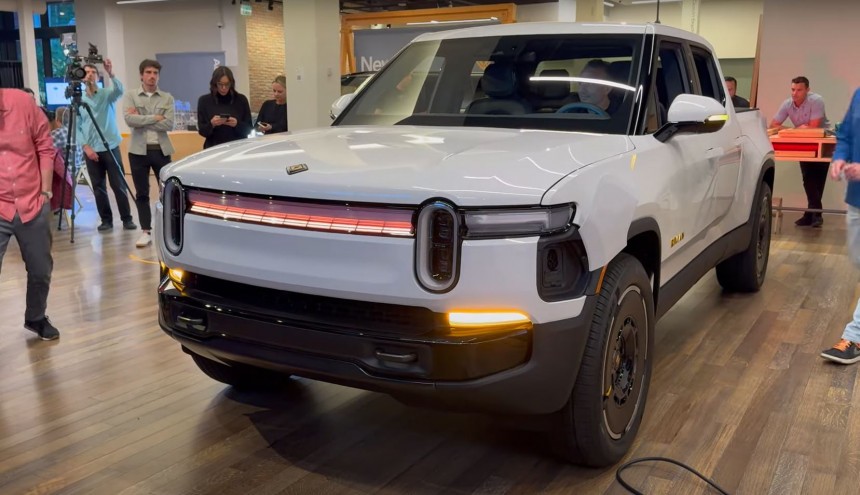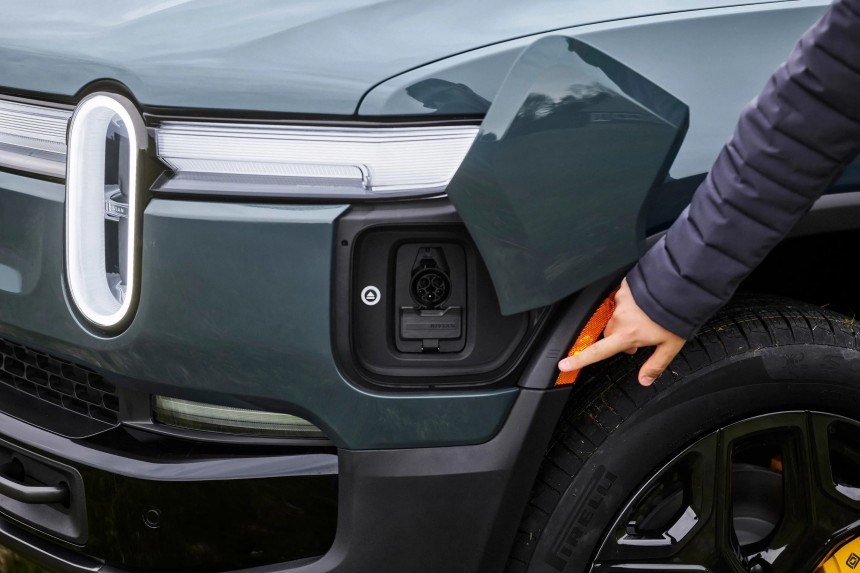If you want a good EV, chances are you might be already considering Rivian's pickup truck or three-row SUV as new members of your household. Both have made a name for themselves and are pretty popular, even though production only started around three years ago. But now that the Irvine-based brand has carved a clear path forward for itself and assured everyone that it would remain in business, it's customers' turn to make the right choices. Let us help you.
Last year, Rivian introduced a new battery option for the R1T and R1S – the Max Pack. It wanted $10,000 for it, even though its actual gross size was 149 kWh, not 180 kWh as initially hinted.
It wasn't much of an upgrade over the 141-kWh Large Pack. What was truly different was the cell chemistry. Samsung updated the design (53G), which increased the energy storage capacity by six percent without making it much more expensive than the existing (50G) energy storage unit. It only added a bit more weight: 17.2 lb, to be precise.
Both the Large and Max Pack featured the same ~400V architecture, the same nine modules, and the same nickel-cobalt-aluminum (NCA) cathode. The new cell pack enabled the R1T to go slightly over the 400-mile (644-kilometer) mark, which represented an EPA-rated range increase of about 58 miles (93 kilometers) over the Large Pack.
In a real-world range test, an R1T with the Max Pack covered almost 30 miles (48 kilometers) more than an R1T with the Large Pack. It could have been a win for the more expensive high-voltage energy storage unit. However, the drivers discovered that the Max Pack had a buffer of 0.2 kWh left before entering turtle mode, while the Large Pack still had 3.9 kWh of energy in it.
Rivian wasn't very clear about the Max Pack and didn't promote it heavily or transparently as it did with many of its other products or features. It made many feel like the new pack was just a cash grab. However, it also didn't exaggerate the pack's capabilities. At the company's helm, there's a cool CEO, one who doesn't feel the need to regularly go overboard with statements.
Another proof that Rivian is very serious about its future, apart from convincing VW to invest a few billions in it, is that it quickly learns from its minor mistakes and rectifies them as soon as possible.
The refreshed R1T and R1S are the best examples in this regard.
The EPA-rated range varies depending on the preferred powertrain, but what we're looking at is:
Pair the batteries with the available in-house developed drive units, and you get the following MSRPs:
The new 1,025-hp quad-motor powertrain is not yet available, but when it eventually lands, it will probably be more expensive than the models with three motors.
But it's not the number of motors that makes speccing a 2025 R1S or a 2025 R1T right a challenge. It's the high-voltage battery.
LFP packs have the distinct advantage of putting up better with 100 percent charges. Even though they have a smaller energy capacity (92.5 kWh), drivers will be able to drive the maximum possible distance more often. Other chemistries degrade faster if they're often plugged into DC fast chargers or replenished to their maximum capacity.
On the other hand, the Large and the Max packs can charge a bit faster (220 kW vs. 200 kW) and can hold more energy (109.4 kWh for Large and 141.5 kWh for Max). But for ideal commuting needs and to prevent degradation, these energy storage units should be charged to about 80 percent, which means the driver ends up using 87.5 kWh with the Large and 113.2 kWh with the Max.
Taking the R1T as an example, the maximum EPA-rated range possible with the NMC packs becomes 264 miles (425 kilometers) and 336 miles (541 kilometers), respectively, in a situation where the owner wants to take good care of the battery.
That brings us back to the LFP pack, which can theoretically enable both the SUV and the pickup truck to cover 270 miles on a single charge. Why go for the Large – a $7,000 upgrade – when the more affordable version can cover the same distance?
If you want better range and improved fast charging capabilities, the obvious choice is the Max Pack, which costs $14,000 more than the Standard LFP pack. It's double the price, but you at least get a sensible upgrade. There's quite a noticeable difference between 270 and 420 miles (410 miles for the R1S).
But then, you'd have to answer another question: can you live without the $5,000 132-hp and 219 lb-ft of torque software-locked Performance upgrade? It only works with the Large and Max packs.
That can translate into more stops to recharge while driving longer distances or plugging in at home overnight more often. In such scenarios, the best R1T or R1S makes the most sense, even though both are pretty pricey.
LFP batteries perform particularly worse when the weather isn't playing nice. Last winter, we learned from Tesla owners that these energy storage units might need special attention. With temperatures dropping below freezing level, many Teslas were unable to fast charge out in the open. They had to be warmed up first or kept plugged in for at least 30 to 50 minutes to wake up.
Choosing the Max pack also makes sense for drivers who tow often. The more range you have, the longer you can go before stopping to replenish the battery.
So, where does all this leave the middle option, the Large pack? It's good that it is available, but it seems like too much of a compromise to be considered by most people willing to spend at least $77,000 on a pickup truck or $83,000 on an SUV. It only adds 60 miles of range over the LFP pack, and can't be charged constantly to 100 percent without accelerating degradation, which translates into losing range in the long run. It takes 3,000 charging cycles to lose around 20 percent of the initial maximum range, according to a study conducted on Samsung NMC cells.
All in all, the best bang for your buck is the Standard or the Max pack. The Large battery seems to be there only for those who are undecided.
It wasn't much of an upgrade over the 141-kWh Large Pack. What was truly different was the cell chemistry. Samsung updated the design (53G), which increased the energy storage capacity by six percent without making it much more expensive than the existing (50G) energy storage unit. It only added a bit more weight: 17.2 lb, to be precise.
Both the Large and Max Pack featured the same ~400V architecture, the same nine modules, and the same nickel-cobalt-aluminum (NCA) cathode. The new cell pack enabled the R1T to go slightly over the 400-mile (644-kilometer) mark, which represented an EPA-rated range increase of about 58 miles (93 kilometers) over the Large Pack.
In a real-world range test, an R1T with the Max Pack covered almost 30 miles (48 kilometers) more than an R1T with the Large Pack. It could have been a win for the more expensive high-voltage energy storage unit. However, the drivers discovered that the Max Pack had a buffer of 0.2 kWh left before entering turtle mode, while the Large Pack still had 3.9 kWh of energy in it.
Tricky picks
So, in the long run, the Large Pack found on non-refreshed units might have the upper hand because the brand can remotely unlock a bit more capacity to offset degradation. Moreover, a larger buffer might guarantee a longer lifespan because the battery isn't constantly forced to reach its lowest state of charge when road-tripping or in cases when the driver forgets to charge it to an appropriate level.Another proof that Rivian is very serious about its future, apart from convincing VW to invest a few billions in it, is that it quickly learns from its minor mistakes and rectifies them as soon as possible.
The refreshed R1T and R1S are the best examples in this regard.
A new paradigm brings new challenges
Besides better cameras, revised suspension, new lighting signature, different wheels, novel drive units, cooler cabin materials, changed trims, and simpler internals, the refreshed R1T and R1S benefit from three battery options:- A 270-mile lithium iron phosphate (LFP) pack; [STANDARD]
- A 330-mile nickel manganese cobalt (NMC) pack; [LARGE]
- A 420-mile (for the R1T) and 410-mile (for the R1S) nickel manganese cobalt (NMC) pack. [MAX]
- A 92.5-kWh STANDARD pack with a maximum charging speed of 200 kW;
- A 109.4-kWh LARGE pack with a maximum charging speed of 220 kW;
- A 141.5-kWh MAX pack with a maximum charging speed of 220 kW.
Pair the batteries with the available in-house developed drive units, and you get the following MSRPs:
- R1T
- Dual-Motor + STANDARD = $69,900;
- Dual-Motor + LARGE = $76,900;
- Dual-Motor + MAX = $83,900;
- Tri-Motor + MAX = $99,900.
- R1S
- Dual-Motor + STANDARD = $75,900;
- Dual-Motor + LARGE = $82,900;
- Dual-Motor + MAX = $89,900;
- Tri-Motor + MAX = $105,900.
The new 1,025-hp quad-motor powertrain is not yet available, but when it eventually lands, it will probably be more expensive than the models with three motors.
LFP packs have the distinct advantage of putting up better with 100 percent charges. Even though they have a smaller energy capacity (92.5 kWh), drivers will be able to drive the maximum possible distance more often. Other chemistries degrade faster if they're often plugged into DC fast chargers or replenished to their maximum capacity.
On the other hand, the Large and the Max packs can charge a bit faster (220 kW vs. 200 kW) and can hold more energy (109.4 kWh for Large and 141.5 kWh for Max). But for ideal commuting needs and to prevent degradation, these energy storage units should be charged to about 80 percent, which means the driver ends up using 87.5 kWh with the Large and 113.2 kWh with the Max.
Taking the R1T as an example, the maximum EPA-rated range possible with the NMC packs becomes 264 miles (425 kilometers) and 336 miles (541 kilometers), respectively, in a situation where the owner wants to take good care of the battery.
That brings us back to the LFP pack, which can theoretically enable both the SUV and the pickup truck to cover 270 miles on a single charge. Why go for the Large – a $7,000 upgrade – when the more affordable version can cover the same distance?
But then, you'd have to answer another question: can you live without the $5,000 132-hp and 219 lb-ft of torque software-locked Performance upgrade? It only works with the Large and Max packs.
Figuring out the ideal pick
Now, we must get into specifics. If you live in an area where winter makes itself noticeable through low temperatures or in some place where you can't drive without A/C on full blast, you must consider a drop in the maximum range of about 30 percent.That can translate into more stops to recharge while driving longer distances or plugging in at home overnight more often. In such scenarios, the best R1T or R1S makes the most sense, even though both are pretty pricey.
Choosing the Max pack also makes sense for drivers who tow often. The more range you have, the longer you can go before stopping to replenish the battery.
So, where does all this leave the middle option, the Large pack? It's good that it is available, but it seems like too much of a compromise to be considered by most people willing to spend at least $77,000 on a pickup truck or $83,000 on an SUV. It only adds 60 miles of range over the LFP pack, and can't be charged constantly to 100 percent without accelerating degradation, which translates into losing range in the long run. It takes 3,000 charging cycles to lose around 20 percent of the initial maximum range, according to a study conducted on Samsung NMC cells.
All in all, the best bang for your buck is the Standard or the Max pack. The Large battery seems to be there only for those who are undecided.
